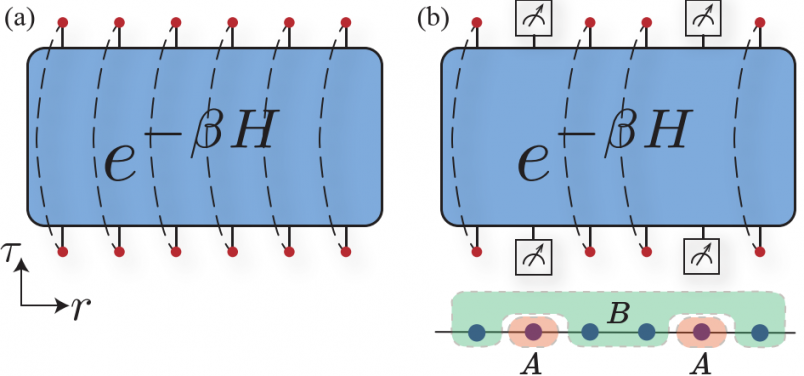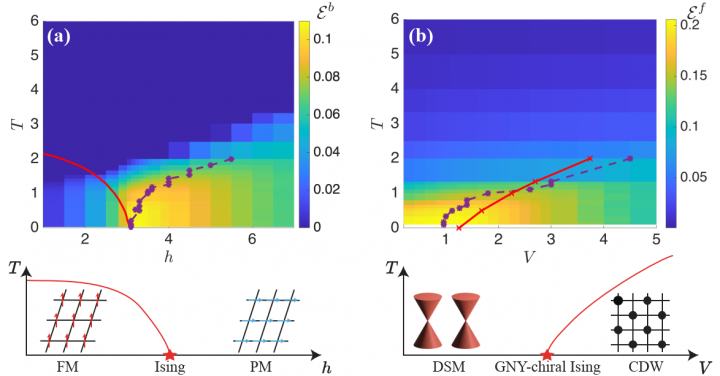Media
HKU Physicists Pioneer Entanglement Microscopy Algorithm to Explore
How Matter Entangles in Quantum Many-Body Systems
23 Jan 2025
Figure 4. Ting-Tung WANG (left) and Menghan SONG, PhD students from the HKU Department of Physics, are co-authors of the journal paper.

Figure 2. Sampling the reduced density matrix (RDM) in path-integral quantum Monte Carlo (QMC). Panel (a) shows the partition function in the space time manifold appearing in usual QMC simulations. Panel (b) shows how the RDM is sampled in such QMC simulations, where one imposes open boundary conditions in time for the skeletal sites in subregion A. The lower panel in (b) demonstrates the spatial partition of A and B in such a setting.

Figure 3. Logarithmic negativity as a measurement of quantum entanglement for adjacent sites in (a) 2d transverse-field Ising model and (b) 2d fermion t-V model. The bottom panel illustrates the schematic phase diagrams.
- 1 / 4
- 2 / 4
- 3 / 4
- 4 / 4
Quantum entanglement – a phenomenon where particles are mysteriously linked no matter how far apart they are – presents a long-standing challenge in the physical world, particularly in understanding its behaviour within complex quantum systems.
A research team from the Department of Physics at The University of Hong Kong (HKU) and their collaborators have recently developed a novel algorithm in quantum physics known as ‘entanglement microscopy’ that enables visualisation and mapping of this extraordinary phenomenon at a microscopic scale. By zooming in on the intricate interactions of entangled particles, one can uncover the hidden structures of quantum matter, revealing insights that could transform technology and deepen the understanding of the universe.
This study, led by Professor Zi Yang MENG and co-authored by his PhD students Ting-Tung WANG and Menghan SONG of HKU Department of Physics, in collaboration with Professor William WITCZAK-KREMPA and PhD student Liuke LYU from the University of Montreal, unveils the hidden structures of quantum entanglement in many-body systems, offering a fresh perspective on the behaviour of quantum matter. Their findings were recently published in the prestigious journal Nature Communications.
A Breakthrough in Mapping Quantum Entanglement
Quantum entanglement describes a deep connection between particles, where the state of one particle is instantly linked to another, even across vast distances. Imagine rolling two dice in different locations—quantum entanglement is like finding that the outcome of one die always determines the outcome of the other, no matter how far apart they are. This phenomenon, famously called ‘spooky action at a distance’ by Albert Einstein, is not just a theoretical curiosity but underpins technologies like quantum computing, cryptography, and the study of exotic materials and black holes. However, it is intrinsically difficult to obtain the entanglement information in quantum many-body systems both analytically and numerically due to the exponentially large degree of freedoms.
Researchers have addressed this challenge by developing ‘entanglement microscopy’, an innovative protocol based on large-scale quantum Monte Carlo simulation that can successfully extract the quantum entanglement information in small regions of quantum systems. By focusing on these microscopic areas, this method reveals how particles interact and organise themselves in intricate ways, especially near critical points in quantum phase transitions—special states where quantum systems undergo profound changes in behaviour.
Their exploration focused on two prominent models at two-dimension: the transverse field Ising model and fermionic t-V model that realises the Gross-Neveu-Yukawa transition of Dirac fermions, each revealing fascinating insights into the nature of quantum entanglement. They discovered that at the Ising quantum critical point, entanglement is short-range, meaning particles are connected only over small distances. This connection can abruptly vanish due to changes in distance or temperature—a phenomenon known as ‘sudden death’. In contrast, their investigation of the fermionic transition revealed a more gradual decline in entanglement even at larger separations, indicating that particles can maintain connections despite being far apart.
Intriguingly, the team discovered that in two-dimensional Ising transitions, three-party entanglement was absent, yet present in one-dimensional systems. This implies that system dimensionality significantly affects entanglement behaviour. To simplify, low-dimensional systems are akin to a small group of friends where deep connections (complex multi-particle entanglement) are more probable. Conversely, high-dimensional systems, comparable to larger, more complex social networks, often suppress such connections. These findings provide important understanding of how entanglement structure alters with increasing system complexity.
Applications and Impact
This breakthrough has significant implications for advancing quantum technologies. By providing a clearer understanding of entanglement, it could help optimise quantum computing hardware and algorithms, enabling faster problem-solving in fields like cryptography and artificial intelligence. It also opens the door to designing next-generation quantum materials with applications in energy, electronics, and superconductivity. Furthermore, this tool could deepen our understanding of fundamental physics and improve quantum simulations in chemistry and biology.
The findings are detailed in the paper ‘Entanglement microscopy and tomography in many-body systems’, published in the journal Nature Communications. The full paper can be accessed at https://rdcu.be/d5oSa
For media enquiries, please contact Ms Casey To, Assistant Manager (Communications) (tel: 3917 4948; email: caseyto@hku.hk / Ms Cindy Chan, Assistant Director of Communications of HKU Faculty of Science (tel: 3917 5286; email: cindycst@hku.hk).
Images download and captions: https://www.scifac.hku.hk/press

